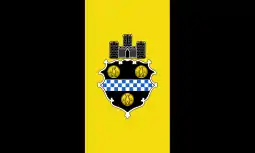| ||||||||||||||
| ||||||||||||||
| ||||||||||||||
| Elections in Pennsylvania |
|---|
 |
|
|
The 1917 Pittsburgh mayoral election was held on Tuesday, November 6, 1917. Edward V. Babcock was elected over William A. Magee in a nonpartisan election.
Primary election
The 1917 contest was conducted under a nonpartisan election law that eliminated party labels from ballots and replaced party primaries with a single nonpartisan blanket primary. This law, enacted prior to the 1913 election, remained in effect until it was repealed prior to the 1921 race.[1]
Incumbent mayor Joseph G. Armstrong was ineligible for re-election owing to a law then in force preventing mayors from serving consecutive terms. Former mayor William A. Magee, who was similarly barred from succeeding himself in 1913, sought the office again in 1917. His main opponents were lumber magnate and former city councilman Edward V. Babcock and city council president Dr. James P. Kerr.[1]
The primary vote was as follows: Babcock, 31,138; Magee, 25,925; and Kerr, 16,620; with a small number of votes going to five other candidates.[2]
Final election
A final election round was held between the top two finishers in the primary, with Babcock beating Magee by 4,555 votes.[1] Kerr and socialist Albert R. Jerling received a smattering of write-in votes.[3]
| Candidate | Votes | % | |
|---|---|---|---|
| Edward V. Babcock | 40,691 | 52.9 | |
| William A. Magee | 36,136 | 47.0 | |
| Albert R. Jerling | 79 | 0.1 | |
| James P. Kerr | 16 | 0.02 | |
| Total votes | 76,922 | 100.0 | |
References
- 1 2 3 Townley, John B. (June 23, 1934). "Pittsburgh Has Had Three Democratic Mayors in 50 Years". The Pittsburgh Press. p. 16.
- ↑ "Official Count Completed; Primary Vote Certified". The Gazette Times. Pittsburgh. October 5, 1917. p. 5.
- 1 2 "Official Count Gvies Babcock 4,555 Lead". The Gazette Times. Pittsburgh. November 24, 1917. p. 9.
| Preceded by 1913 |
Pittsburgh mayoral election 1917 |
Succeeded by 1921 |

